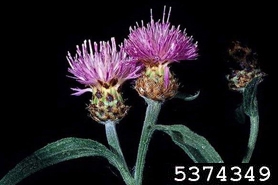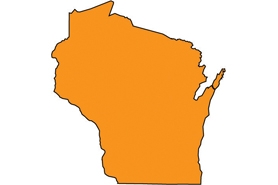Black knapweed
(Centaurea nigra)
Perennial knapweed, with purple flowers and black bracts, growing up to 5 feet tall.
Other names for this plant include:
- Common names: Lesser knapweed, hardheads, Spanish buttons, common knapweed
- Scientific names: Centaurea nigra var. radiata
Classification in Wisconsin: Restricted
- Ecological Threat
-
- Invades open grasslands, prairies, open forests, orchards, cultivated fields, field edges, and travel corridors.
- Aggressively outcompetes desired vegetation, reducing overall biodiversity and forage quality.
- Plants are easily spread by human activity via seed.
- It increases soil erosion and consumes soil nutrients.
- Identification
-
Leaves & stems: Stems are erect and covered in fine hairs, branching near the middle. Basal leaves are borne on leaf stalks and are narrow. The widest section of the leaf is in the middle. Leaves progressively get smaller up the stalk. Leaf margins (edges) are mostly smooth to lightly serrated.
Flowers: Flowering occurs at branch tips. Flower heads are composed of 40 to over 100 individual flowers, purple to white in color with black bracts.
Fruits & seeds: Seeds may have short bristles on one end. Reproduces prolifically by seed.
Roots: Plants have woody taproots and a woody root crown.
Similar species: Black knapweed closely resembles other knapweeds, the majority of which are also invasive in Wisconsin.
- Control
- Mechanical:
- Handpull the plants, being sure to remove the entire taproot.
- Mow or cut plants before flowering to prevent seed-set. Note this will not kill the plants but suppress them.
- Herbicide treatments are most effective when combined with other control techniques and followed by re-seeding. The timing of herbicide treatments is essential to effectiveness.
- Glyphosate, picloram, 2, 4-D, and clopyralid have all been used on other knapweeds.
- Gall flies (Urophora affinis and Urophora quadrifasciata) are used to feed on the developing seed heads.
- Resources
- Sources for content:
- Washington State Noxious Weed Control Board
- USDA Forest Service


